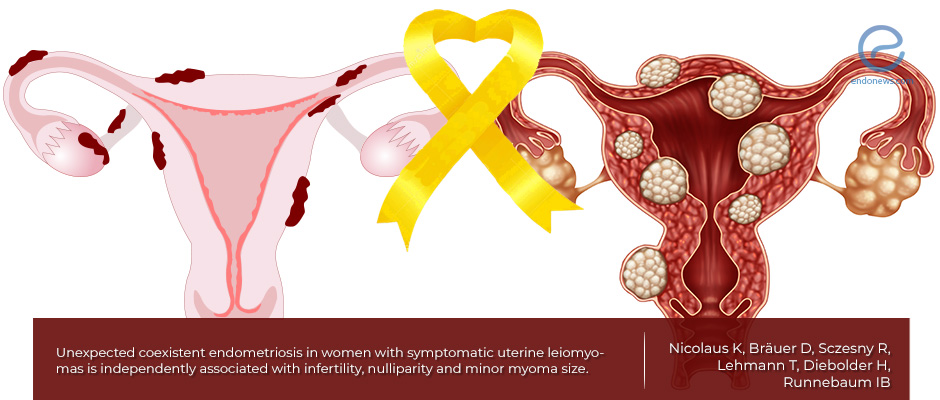The predictors for the coexistence of uterine leiomyomas and endometriosis
Jul 3, 2019
Nulliparity, infertility and minor myoma size are independent risk factors to predict the coexistence of uterine leiomyomas and endometriosis.
Key Points
Highlights:
- The identification of risk factors for the coexistence of uterine leiomyomas and endometriosis will provide appropriate preoperative counseling before surgical therapy.
Importance:
- Unexpected endometriosis can be encountered in women who undergo laparoscopic myomectomy because both diseases have some common features.
- As preoperative detection is easy for leiomyomas, the patients who have concomitant endometriosis will benefit if we know the details.
What’s done here?
- This single-center retrospective cohort study was conducted in the University Women’s Hospital endometriosis center.
- WOnly the women who underwent laparoscopic myomectomy due to symptomatic uterine leiomyoma during five years were included in the study.
- The presence of histologically confirmed endometriosis sampled by the visualization during laparoscopy was the main outcome of the study.
- The demographic and clinical characteristics including age, parity, previous operations, uterine size, the number and location of leiomyomas, duration of the surgery, conversion to laparotomy, surgical procedures, endometriosis stages, histological findings, length of hospital stay, complications, progress information, and postoperative 3-months follow-up were recorded.
- Postoperative complications such as any deviations from the perioperative standard for prescribed medication, blood transfusion and/or secondary surgery during the inpatient stay and 48 h thereafter were also evaluated.
Key results:
- Among a total of 223 patients, 57(25.6%) had histologically confirmed endometriosis, whereas remaining 166(74.4%) did not.
- Nulliparity, infertility and having smaller leiomyoma in size appeared as independent risk factors for the coexistence of uterine leiomyoma and unexpected endometriosis.
- No difference found between the patients with and without endometriosis concerning endometriosis symptoms (bleeding abnormalities, pain, dysmenorrhea, previous surgical interventions, number, weight, and locations of leiomyomas, and complications.
- Women having coexistent diseases had significantly longer operation time.
- In patients with unexpected endometriosis, the most common stages were stage 1 (29.8%) and 2 (29.8%), and the lesser pelvis (75.4%) was the most common location.
Lay Summary
Uterine leiomyomas are the most common gynecological benign tumors affecting 20-25% of reproductive-aged women. Abnormal bleeding, pelvic pain, pelvic pressure, and infertility are major symptoms of these tumors.
Endometriosis is another gynecological disease encountered in 10-15% of reproductive-aged women. The most common symptoms are dysmenorrhea, dyspareunia, chronic pelvic pain, and infertility.
Both diseases share some common features such as estrogen dependence, similar potential symptoms, and genetic predisposition. Ultrasound and/or magnetic resonance imaging can be used for the accurate differential diagnosis.
However, uterine leiomyomas are more easily recognized with the current imaging methods.
Nicolaus et al, a group of scientists from Germany, published a study titled as “Unexpected coexistent endometriosis in women with symptomatic uterine leiomyomas is independently associated with infertility, nulliparity and minor myoma size” in the journal named Archives of Gynecology and Obstetrics. The authors aimed to evaluate the prevalence of unexpected endometriosis in women who underwent laparoscopic myomectomy.
They found that patients (25.6%) had histologically confirmed endometriosis at the end of surgical intervention of uterine leiomyomas, whereas remaining patients (166 women (74.4%) did not. They also found out that nulliparity, infertility and having smaller leiomyoma in size were independent risk factors for the coexistence of both diseases. There was no difference between the patients with and without endometriosis concerning endometriosis symptoms such as abnormal bleeding, pain, dysmenorrhea, previous surgical interventions, leiomyomas related factors (number-weight-locations), and operation complications. Those women with the coexistent leiomyoma and endometriosis had significantly longer operation time. Furthermore, patients with unexpected endometriosis had earlier stage endometriosis and the location was lesser pelvis in most cases.
“Unexpected coexistent endometriosis in women who undergo laparoscopic myomectomy due to symptomatic uterine myomas should commonly be expected,” they added.
Research Source: https://www.ncbi.nlm.nih.gov/pubmed/31006843
endometriosis uterus leiomyoma coexistent laparoscopic myomectomy nulliparity infertility size

